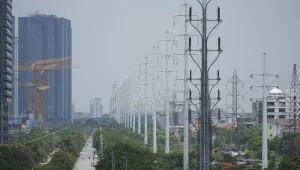The full discussion paper is available for download here: http://belfercenter.ksg.harvard.edu/publication/25038/
OVERVIEW
Plants draw carbon dioxide from the atmosphere as they grow, sequestering the carbon in biomass and thus helping to mitigate climate change. This mitigation has an economic value commensurate with reduced damages from climate change. However, the U.S. National Park Service (NPS) has not calculated the carbon-sequestration benefits provided by the 84 million acres of land it manages, even though 85% of this land is vegetated.
The NPS has a dual mission—to foster both tourism ("visitation" to those researching this topic) and land stewardship. Measuring the value of carbon sequestration would complement ongoing attempts to measure the economic value of tourism by providing an initial estimate of the economic importance of one component of the NPS's stewardship obligations.
BACKGROUND
Calculating the value of carbon sequestration services provided by NPS land is a matter of determining the amount of carbon sequestrated and multiplying this quantity by some estimate of the economic value of damages incurred or expected to be incurred from climate change. Based on various models of this "damage function," the U.S. government has estimated the "social cost of carbon" (SCC) at $40.45 per metric ton. The authors use this SCC—along with their preferred discount rate—to calculate the economic value of carbon sequestered.
The rate of sequestration on NPS land was found by combining several national spatial-ecological datasets. Geographic data on the borders of all NPS units (national parks and other NPS land) were combined with data from the National Land Cover Database to calculate the total area of forest, grassland, and wetland in each NPS unit. To estimate the amount of carbon sequestered by the land area in each of these vegetation classes the authors use the U.S. Geological Survey's LandCarbon National Assessment Program, which provides the net ecosystem carbon balance (NECB)—the rate at which carbon is sequestered—for various classes of vegetation in various parts of the country. Multiplying the NECB by the acreage of each vegetation type in the various units of NPS-managed land provides an estimate of the amount of carbon sequestered. Multiplying this total by an SCC of $40.45 per metric ton yields an estimate of the economic value of carbon sequestration on NPS land (that is, the value of avoided damages from climate change).
KEY FINDINGS
- The annual value of carbon sequestration on NPS land is $708 million. Excluding NPS marine reserves and land in Alaska (due to a lack of data), lands managed by the NPS sequestered an average of 17.5 million metric tons of carbon annually between 2001 and 2005. Two-thirds of this total came from sequestration in national parks (rather than from national monuments and other NPS managed land).
- The Everglades account for nearly one-fifth of the total carbon sequestration calculated for all NPS-managed land.
- A large gap separates high and low estimates of sequestration. LandCarbon reports a range of possible NECB values. Estimated sequestration rates based on the largest of these values are more than seven times those based on the smallest. Using the largest NECB values indicates that NPS land sequesters nearly 30 million tons while the smallest estimates suggest sequestration of just over 4 million metric tons.
- The value of sequestration is equivalent to 25% of the NPS budget. The 2014 NPS budget was $2.5 billion. At $700 million per year, the value of sequestered carbon estimated in this analysis amounts to more than onequarter of taxpayer expenditures to support the NPS and more than twice the $329 million appropriated in 2014 for "resource stewardship."
- Future warming may reduce sequestration. Heat stress and climate-induced ecosystem changes are predicted to reduce annual sequestration rates to an average of 12 million metric tons between 2006 and 2050. Active management by the NPS may be able to offset some of this decline.
CONCLUSIONS
The analysis summarized here provides an estimate of the value of carbon sequestration occurring on NPS land and a methodology for estimating sequestration benefits that can be applied to the rest of the 640 million acres of land owned by the U.S. federal government. These estimates help to measure some of the economic value created by the NPS that is not captured in more conventional measures of economic impact, like visitor spending. The results of this analysis indicate that the economic value of carbon-sequestration benefits from NPS-managed lands may be equivalent to a sizeable portion of the overall NPS budget. These estimates are conservative, as they exclude more than 54 million acres managed by the NPS in Alaska and in marine reserves. Finally, projected sequestration rates for the years 2006 to 2050 indicate that ecosystem stresses induced by climate change, including warmer temperatures and increased fires, will reduce future sequestration on public lands. Active management by the NPS to maintain sequestration rates may be able to offset some of these reductions.
1.Based on analysis of the 2011 National Land Cover Database. National Land Cover Database 2011, 2014. http://www.mrlc.gov/nlcd2011.php.
Banasiak, Adam, Linda Bilmes and John Loomis. “Carbon Sequestration in the U.S. National Parks: A Value Beyond Visitation—Summary.” September 2015





